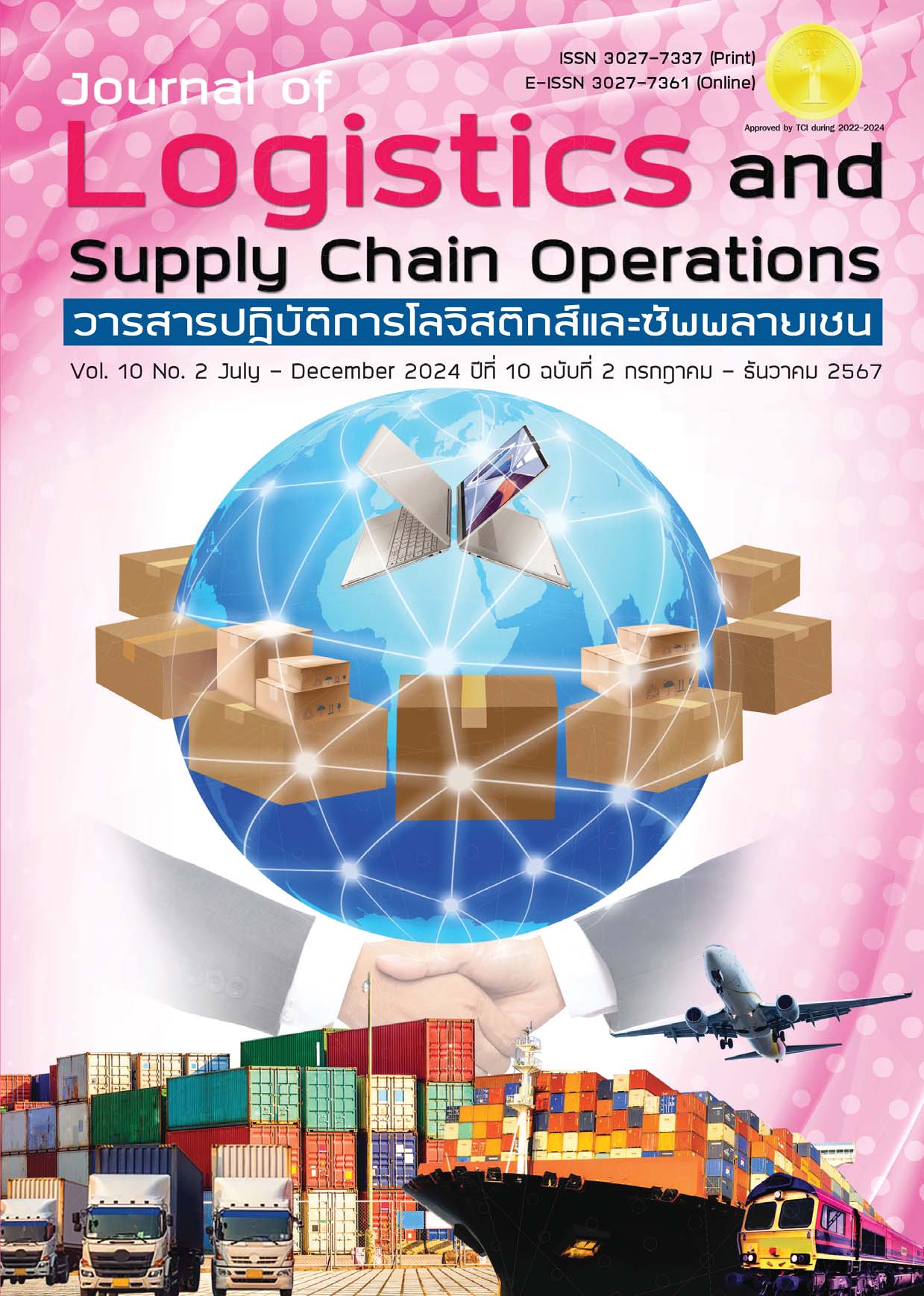The Development of Prototype Packaging for Ban Chiang Krom Rice Community Enterprise Products in The Form of Souvenirs with a Local Identity
DOI:
https://doi.org/10.53848/jlsco.v10i2.265993Keywords:
Prototype Packaging, Ban Chiang Krom Rice Community Enterprise, Local IdentityAbstract
This article aims to 1) study and research the product identity of Ban Chiang Krom Rice Processing Community Enterprise in order to develop a packaging prototype of Ban Chiang Krom Rice Community Enterprise in the form of a souvenir with a local identity. 2) Develop packaging prototypes for Ban Chiang Krom rice processing community enterprise products in the form of souvenirs with a local identity and 3) generate a guideline model to increase the level of purchase intent from a marketing model suitable for Ban Chiang Krom Rice Processing Community Enterprise products that have been developed for packaging in the form of souvenirs with local identity. The study used a combination of qualitative and quantitative research methods. Information was gathered from local villagers who consumed steamed rice produced by the cooking process. To find ways to create a unique packaging identity. Indepth interviews with 7 main informants were conducted, 385 questionnaires were distributed,and hypotheses were tested in relation to context-specific marketing modeling approaches. The findings revealed that 1) red lotus buds in the upper corner. In the community, the red lotus flower represents the local symbol of the area. 2) It was created as a packaging model,resulting in Ban Chiang Krom rice processing products with distinct packaging and a distinct
identity and 3) a study prototype was used to create a marketing model after testing the hypothesis, it was discovered that the generated marketing equation model was consistent with the empirical data and could be used as a guideline model to increase the level of purchase intent from the marketing model suitable for enterprise products. Ban Chiang Krom Rice Processing Community has developed packaging for the Ban Chiang Krom Rice Community Enterprise in the form of souvenirs with local identity.
References
กรมการค้าภายใน. (2565). ข้อมูลสถิติผู้ประกอบการค้าข้าวไทย. ค้นเมื่อ 15 ตุลาคม 2565, จาก: https://www.dit.go.th
กรมการปกครอง. (2565). ตำบลบ้านเชียงกรม อำเภอท่าม่วง จังหวัดอุดรธานี. ค้นเมื่อ 15 ตุลาคม 2565, จาก: https://www.dopa.go.th/
กัลยา วานิชย์บัญชา. (2555). สถิติสำหรับงานวิจัย. พิมพ์ครั้งที่ 6. กรุงเทพฯ: จุฬาลงกรณ์มหาวิทยาลัย.
กิตติกรณ์ บำรุงบุญ และปิยลักษณ์ โพธิวรรณ์. (2564). การพัฒนาผลิตภัณฑ์ของที่ระลึกที่สะท้อนอัตลักษณ์ท้องถิ่นจังหวัดมหาสารคามเพื่อยกระดับมูลค่าทางเศรษฐกิจ. วารสารมนุษยศาสตร์และสังคมศาสตร์ มหาวิทยาลัยมหาสารคาม, 40(2), 7-24.
งามพิศ สัตย์สงวน. (2558). การวิจัยเชิงคุณภาพทางมานุษยวิทยา. พิมพ์ครั้งที่ 7. กรุงเทพฯ: สำนักพิมพ์แห่งจุฬาลงกรณ์มหาวิทยาลัย.
ทวีพร พนานิรามัย. (2557). ปัจจัยที่มีอิทธิพลเชิงบวกต่อความตั้งใจซื้อสินค้าซุปเปอร์มาร์เก็ตออนไลน์ A ของผู้บริโภคในเขตยานนาวา จังหวัดกรุงเทพมหานคร. สารนิพนธ์ปริญญามหาบัณฑิต สาขาบริหารธุรกิจ, มหาวิทยาลัยกรุงเทพ.
นุชนาฎ เชียงชัย. (2558). การใช้อัตลักษณ์เพื่อการส่งเสริมการท่องเที่ยวของจังหวัดลำปาง. วิทยานิพนธ์ปริญญามหาบัณฑิต สาขาบริหารธุรกิจ, มหาวิทยาลัยศิลปากร.
พูนเพิ่ม เสรีวิชยสวัสดิ์. (2562). การยอมรับและการใช้เทคโนโลยี: บทบาทสำคัญต่อพฤติกรรมเชิงสร้างสรรค์ของบุคลากรในอุตสาหกรรมไมซ์ของไทย. วารสารวิทยาลัยดุสิตธานี, 13(3), 505-519.
วิภาวดี พรมพุทธา และขาม จาตุรงคกุล. (2565). โครงการออกแบบอัตลักษณ์ตราสินค้าและพัฒนาผลิตภัณฑ์ผ้าฝ้ายโดยได้แรงบันดาลใจจากดอกไม้เมืองเลย กรณีศึกษาผลิตภัณฑ์ผ้าฝ้ายชุมชนบ้านกาบก อ.วังสะพุง จ.เลย. รายงานสืบเนื่องการประชุมวิชาการเสนอผลงานวิจัยระดับบัณฑิตศึกษาระดับชาติ ครั้งที่ 23 ประจำปี 2565, วันที่ 25 มีนาคม 2565 ณ มหาวิทยาลัยขอนแก่น, 326-344.
สัญญา เคณาภูมิ. (2559). บทวิเคราะห์ปรัชญาเศรษฐกิจพอเพียง: ความเชื่อมโยงแนวปฏิบัติทฤษฎีอื่น. วารสารมหาวิทยาลัยราชภัฏมหาสารคาม (มนุษยศาสตร์และสังคมศาสตร์), 10(2), 69-84.
สุชาวดี ณรงค์ชัย. (2563). ความรู้ ทัศนคติ และความตั้งใจซื้อผลิตภัณฑ์ออร์แกนิคสำหรับดูแลผิวพรรณและเส้นผมของผู้บริโภค. วิทยานิพนธ์ปริญญามหาบัณฑิต สาขาวิชาสื่อสารการตลาด, มหาวิทยาลัยบูรพา.
สุนิฏฐา ภู่พงศ์พันธ์. (2555). ทัศนคติ และความตั้งใจซื้อคูปองส่วนลดค่าสินค้าและบริการผ่านเว็บไซต์พาณิชยกรรมทางสังคมออนไลน์ของผู้บริโภคในเขตกรุงเทพมหานคร. วิทยานิพนธ์ปริญญามหาบัณฑิต สาขาวิชาการตลาด, มหาวิทยาลัยศรีนครินทรวิโรฒ.
Abdullah, Q. A., & Yu, J. (2019). Attitudes and purchase intention towards counterfeiting luxurious fashion products among Yemeni Students in China. American Journal of Economics, 9(2), 53-64.
Amabile, T. M., Conti, R., Coon, H., Lazenby, J., & Herron, M. (1996). Assessing the work environment for creativity. Academy of Management Journal, 39(5), 1154-1184.
Athapaththu, J., & Kulathunga, D. (2018). Factor affecting online purchase intention: Effects of technology and social commerce. International Business Research, 11(10), 111-128.
Bleize, D. N. M., & Antheunis, M. L. (2019). Factors influencing purchase intent in virtual worlds: A review of the literature. Journal of Marketing Communications, 25(4), 403-420.
Chin, W. W., Gopal, A., & Salisburt, W. D. (1997). Advancing the theory of adaptive structuration: The development of a scale to measure faithfulness of appropriation. Information Systems Research, 8(4), 342-367.
Cronbach, L. J. (1970). Essentials of psychological testing. New York: Harper & Row.
El-Zeiny, R. (2019). The novelty of cultural-oriented design: New opportunities for SMEs in the Egyptian furniture Industry. The proceeding of 6th International Scientific Conference on Arts and Humanities SWS 2019, 22-24 October 2019 at Florence, Italy, 337-348.
Fornell, C., & Larcker, D. F. (1981). Evaluating structural equation models with unobservable variables and measurement error. Journal of Marketing Research, 18(1), 39–50.
Hair, J. F., Black, W. C., Babin, B. J., & Anderson, R. E. (2010). Multivariate data analysis. 7th ed. New Jersey: Prentice Hall.
Hair, J. F., Black, W. C., Babin, B. J., Anderson, R. E., & Tatham, R. (2006). Confirmatory factor analysis of the youth experiences survey for sport. Open Journal Statistics, 5(5), 421-429.
Ko, E., Lee, S., Phan, M. C., & Kim, K. H. (2011). Product attributes’ effects on perceived values and repurchase intention in Korea, USA, and France. Journal of Global Scholars of Marketing Science, 21(3), 155-166.
Ko, E., Lee, S., & Whang, H. (2013). Authenticity in traditional culture marketing: Consumers’ perceptions of Korean traditional culture. Journal of Global Fashion Marketing, 4(2), 93-11.
Lert-asavapatra, P., Jermsittiparsert, K., Srivardhana, T., Whangmahaporn, B., & Suwunnamek, O. (2022). Ethnocentrism in the virtual world: When nationalism influences purchase intention in video game. Social Space Journal, 22(1), 161-180.
Powrani, K., & Kennedy, F. B. (2018). The effects of guerrilla marketing on generation consumer’s purchase intention. Asian Journal of Economics, Business and Accounting, 7(1), 1-12.
Qin, Z., Song, Y., & Tian, Y. (2019). The impact of product design with traditional cultural properties (TCPs) on consumer behavior through cultural perceptions: Evidence from the young Chinese generation. Sustainability, 11(426), 1-17.
Rachbini, W., & Agustina, A. (2019). Customer style inventory, the usage of Facebook, and purchase intention: Are they connected. Journal Siasat Bisnis, 23(1), 67-81.
Schwartz, N. E. (1975). Nutrition knowledge, attitude, and practice of high school graduates. Journal of the American Dietetic Association, 66(1), 28-31.
Skavronskaya, L., Moyle, B., & Scott, N. (2020). The experience of novelty and the novelty of experience. Frontiers in Psychology, 11(1), 1-12.
Yildiz, S. (2017). Effects of guerrilla marketing on brand awareness and consumers’ purchase intention. Global Journal of Economics and Business Studies, 6(12), 177-185.
Zhang, T., Wen, H., & Li, X. (2018). A tourist-based model of authenticity of heritage sporting events: The case of Naadam. Sustainability, 11(108), 1-20.
Zhou, J., & George, J. M. (2001). When job dissatisfaction leads to creativity: Encouraging the expression of voice. Academy of Management Journal, 44(4), 682-696.



